How to Master Consultative Selling: Principles, Strategies, and Examples
Casey O'Connor
Consultative selling is an effective approach to sales that is centered around the customer and their needs.
Contrary to a more traditional sales approach (sometimes known as “transactional selling”), consultative selling shifts the focus away from the product’s features and benefits and instead focuses on asking customers open-ended questions, building rapport, and tailoring the product offer around their unique pain points.
While this methodology is sometimes considered “untraditional,” many salespeople actually find that the process comes more naturally to them than a standard sales pitch.
Becoming skilled in consultative selling is simply a matter of understanding the concept and practicing the process — all of which we’ll go over in this article.
Here’s what we’ll cover:
- What Is Consultative Selling?
- Benefits of a Consultative Sales Approach
- Consultative Selling vs. Solution Selling
- The Consultative Sales Process
- Consultative Selling Principles
- Examples of Consultative Selling
- Consultative Selling Strategies for Success
- Consultative Sales Skills to Master
What Is Consultative Selling?
The term might sound trendy, but don’t write it off as a buzzword — when used correctly, consultative selling is a really effective sales method. It’s especially successful for big-ticket deals. 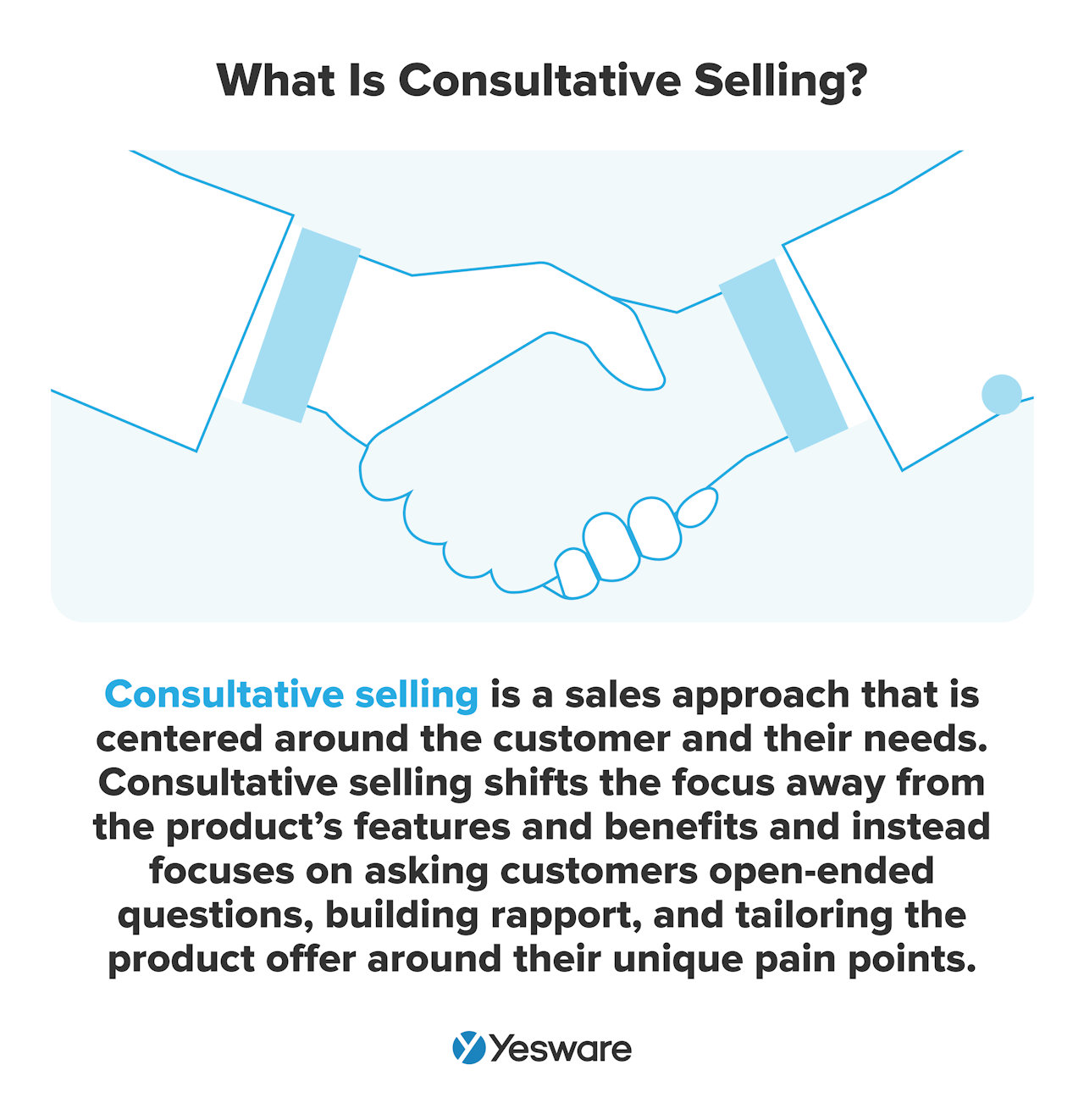 Consultative selling can help you:
Consultative selling can help you:
- Qualify more leads, more efficiently
- Create authentic, trusting, mutually beneficial relationships with clients (which leads to lots of repeat business and referrals)
- Seamlessly solve clients’ problems and help drive their businesses forward
Consultative Sales Explained
In today’s digital age, customers have access to more information than ever. Researching, comparing, and crowdsourcing reviews can all be done quickly and easily online.
As a result, salespeople are interacting with potential customers much later in the sales process than in decades past. In fact, many customers are making purchasing decisions without ever needing to speak to a salesperson at all.
That means that when a sales professional does eventually connect with a potential customer, it’s critical that they can meet the needs of the customer exactly where they are in their buying journey. 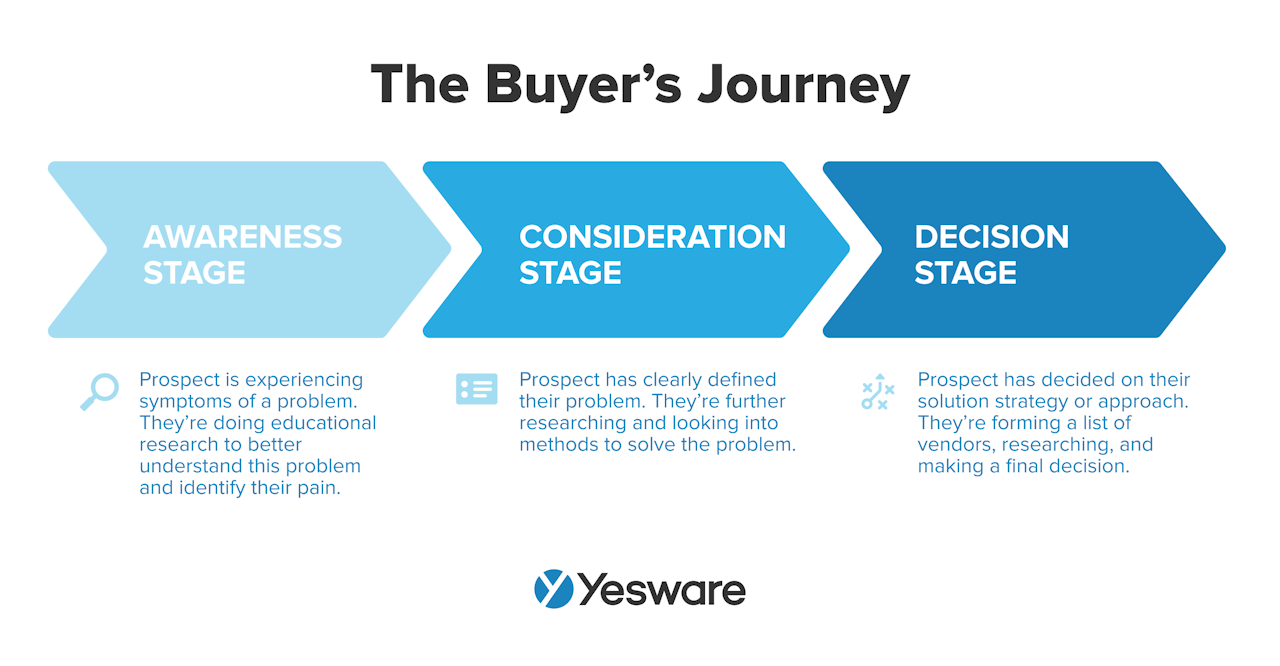 The sales rep needs to be able to speak very specifically to the needs of the client and show a genuine investment in helping them succeed.
The sales rep needs to be able to speak very specifically to the needs of the client and show a genuine investment in helping them succeed.
This is where consultative selling really shines because the process is all about building rapport and earning your client’s trust.
The goal of this approach is not to push your product onto the customer, and they take it or leave it — but instead, to ask thought-provoking questions, empathize with their concerns, and allow them to steer the decision-making process.
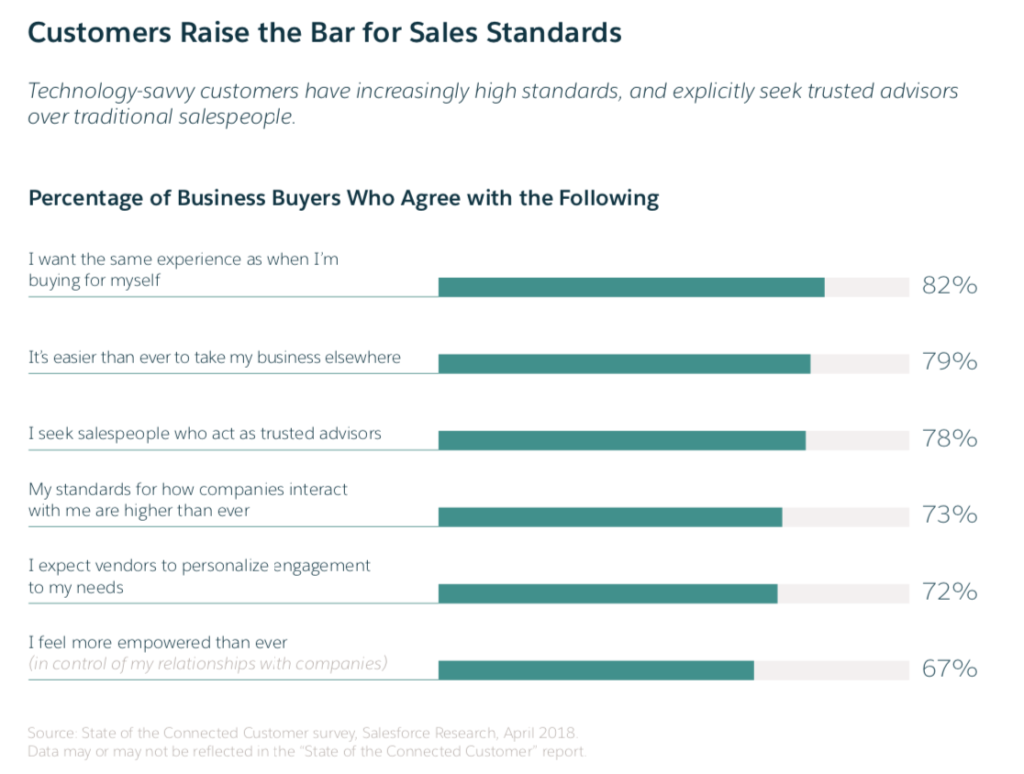
Benefits of a Consultative Sales Approach
Many sales reps find that they naturally gravitate toward a consultative selling approach, even if it isn’t necessarily their organization’s officially prescribed sales methodology. That’s because it has significant and tangible benefits for both buyer and sales rep.
Buyer Benefits
The consultative selling approach is, by design, hyper-sensitive to and focused on the customer’s needs. It emphasizes strong, authentic buyer-seller relationships, which naturally generate high levels of customer satisfaction across accounts.
On a bigger picture scale, consultative selling also improves the buyer’s business and their industry as a whole.
Because consultative selling enables sales reps to become deeply in tune with their buyers’ needs, the approach empowers marketing and sales organizations to truly perfect their product according to the needs of the market, and tailor their campaigns to attract clients who will fully benefit from it.
Seller Benefits
It should come as no surprise that consultative sellers who have a comprehensive understanding of customers’ needs usually create a loyal and profitable base of satisfied customers that are eager to make referrals.
And sellers with this kind of success generally really enjoy what they do.
That’s one of the biggest benefits to sales reps who practice consultative selling: it fosters a sales environment that empowers and enables sales reps to connect with the customer, add value, and create the kind of mutually beneficial relationships that make for a great sales career.
It also helps sellers in many tangible ways:
- More productive customer meetings that quickly get to the heart of what the customer truly needs
- Increased brand awareness and credibility in the market
- Shorter sales cycles
- Better awareness of and insight into customer behavior
All of these benefits, of course, ultimately coalesce to generate a better overall bottom line: more closed-won deals, more high-value accounts, and more revenue.
Consultative Selling vs. Solution Selling
To some, consultative may sound very similar to solution selling. That’s not a bad comparison — the two do share many similarities. In fact, the roots of the consultative selling approach actually come from solution selling.
Both methodologies emphasize prospect over product. And both position the seller as the industry expert who can help the buyer determine how to best approach their problem.
That being said, the two approaches do have subtle differences.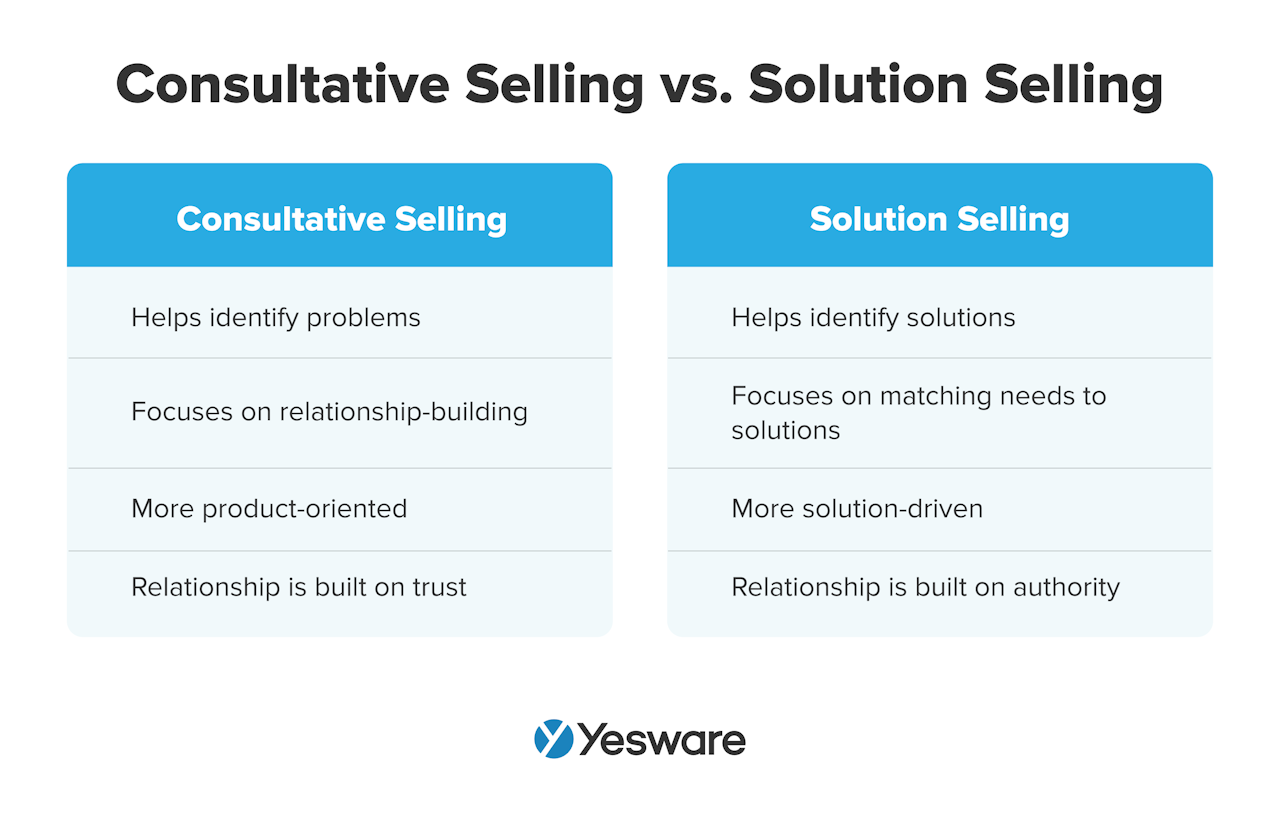 In solution selling, sellers sometimes have the tendency to — as the name implies — push a solution onto a prospect. It can lean toward the transactional side, if sellers aren’t skilled at tailoring their solutions and guiding the conversation in a non-pushy way.
In solution selling, sellers sometimes have the tendency to — as the name implies — push a solution onto a prospect. It can lean toward the transactional side, if sellers aren’t skilled at tailoring their solutions and guiding the conversation in a non-pushy way.
Consultative selling, on the other hand, is intended to offer a more holistic approach to buyer needs. This methodology assumes that the buyer doesn’t just need a solution; in actuality, they need education and resources that can help them understand the full scope of their problem and choose their best solution accordingly.
With a consultative approach, the prospect may or may not buy at the end of the sales cycle — and that doesn’t necessarily mean it was done wrong. The true mark of a successful consultative sales approach is the creation of a trusting, value-based, and long-term relationship between the prospect and sales rep.
According to consultative selling, it’s this relationship — not the solution itself — that is the key to securing future deals, expanding existing accounts, and generating referrals.
The Consultative Sales Process
Don’t worry — the process is pretty straightforward and even somewhat enjoyable to learn! Over time and with practice, each step will feel more natural (and we’re willing to bet the results will speak for themselves). 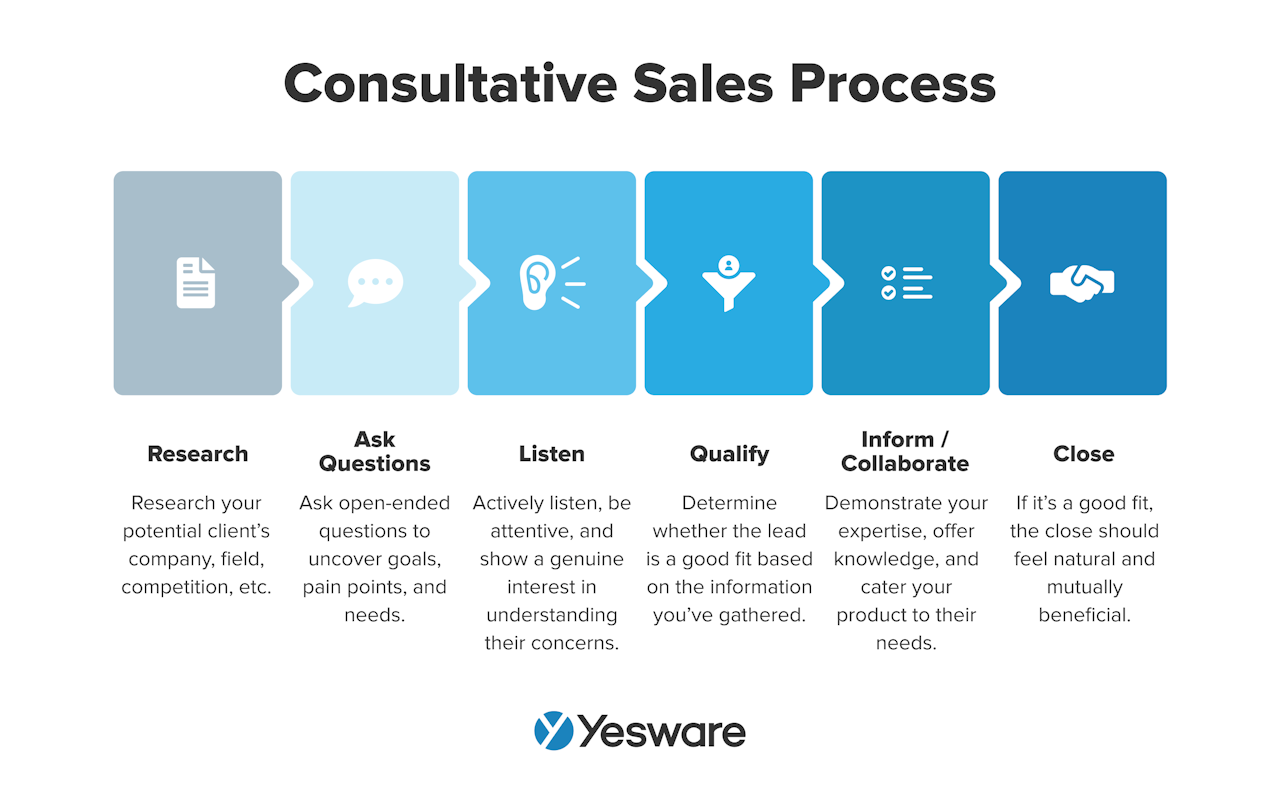 Let’s take a closer look.
Let’s take a closer look.
Step 1: Research (and Then Research Some More)
Of course, researching your potential client’s company is a no-brainer, and should be a key aspect of any sales approach.
Spend time on their company website, LinkedIn, and social media. Check out their online reviews. You might even gather some intel about their competitors to see what sets them apart. These tidbits are all important and will help you build important foundational knowledge about the customer.
Here’s a pre-call research checklist we created that can help you hit every mark while researching. 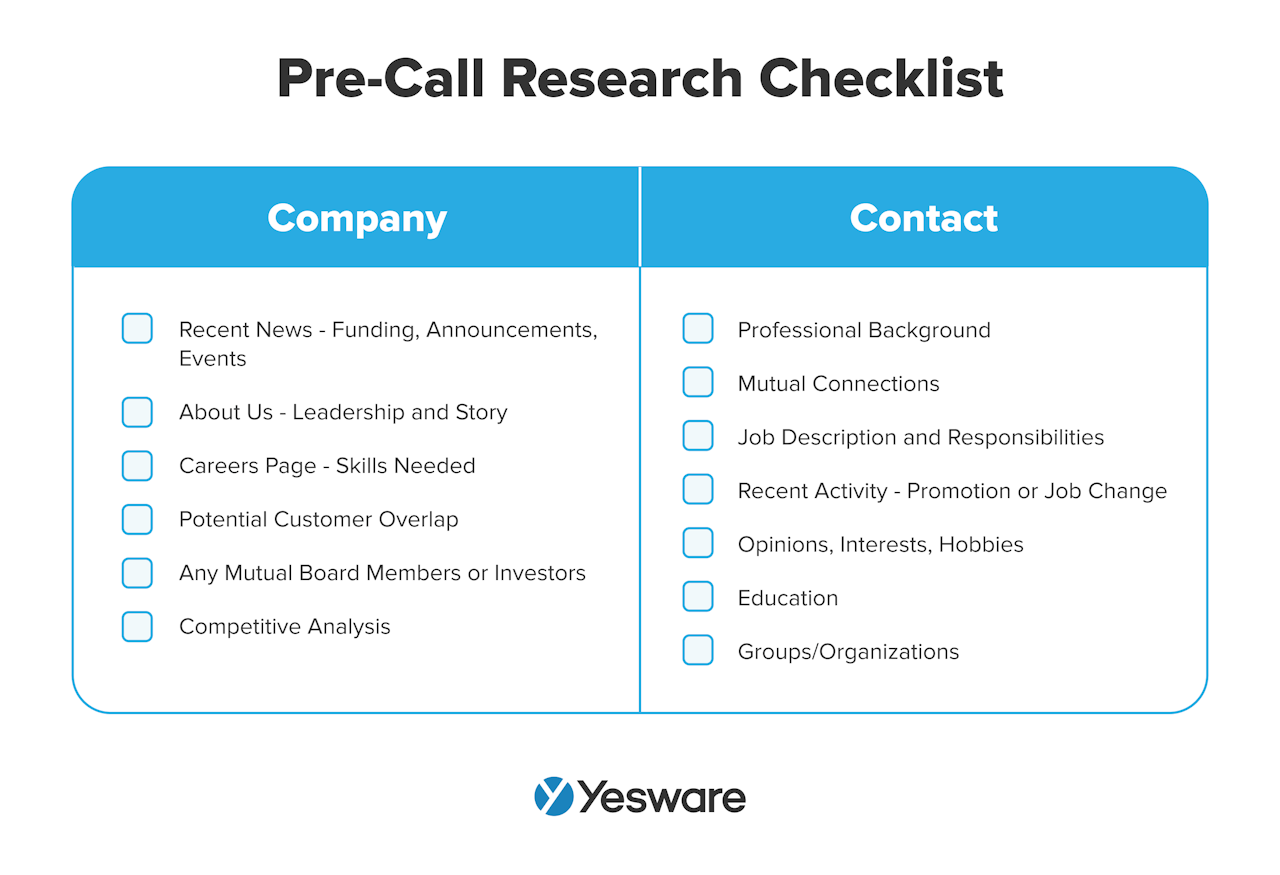 From a consultative selling lens, consider going one step further and researching the client’s field as a whole. For example, let’s say you have a call scheduled with a freight forwarding company. In this field, rates and regulations fluctuate regularly, so being able to craft an offer around up-to-date market conditions will really set you apart from your competition.
From a consultative selling lens, consider going one step further and researching the client’s field as a whole. For example, let’s say you have a call scheduled with a freight forwarding company. In this field, rates and regulations fluctuate regularly, so being able to craft an offer around up-to-date market conditions will really set you apart from your competition.
It may sound silly, but a consultative seller is a bit like a therapist.
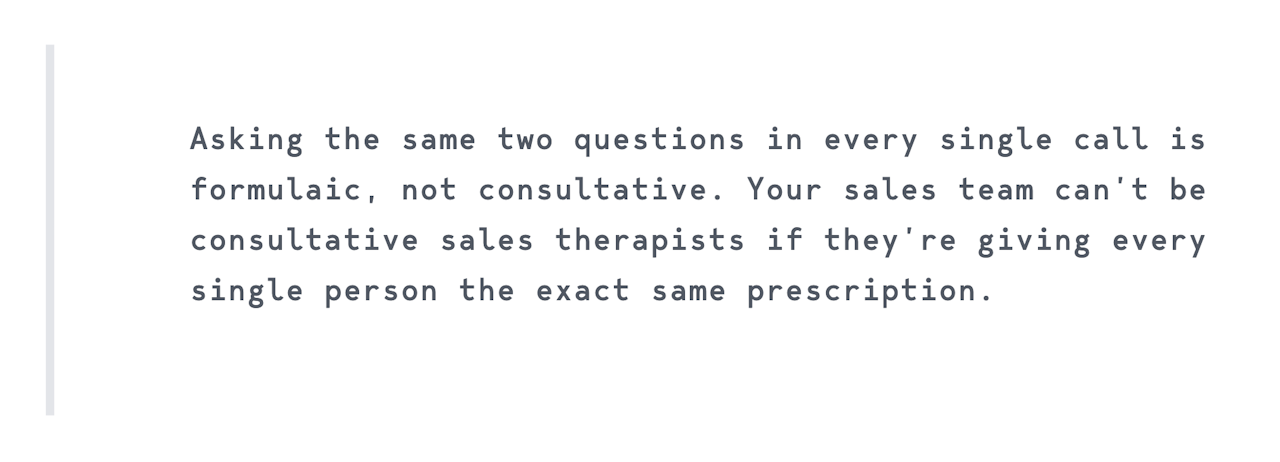
Why?
A therapist’s job is to listen carefully to your concerns, learn about your history and background, and use both of those things to create a custom treatment plan.
A good therapist would never just write a generic prescription and call it a day — you would likely fire them if they did so. Their job is to learn as much about you as they can, so that they can tailor and target the treatment they provide. The more the therapist knows about your motivations, fears, and current and past events in your life, the better they’re able to help you push through barriers and solve problems.
Thankfully, your job as a consultative sales rep is a lot less personal! No need to swap sixth-grade horror stories, but the client should walk away feeling heard, understood, and like you have a keen interest in helping them. Effective research will help you get there.
Step 2: Ask (the Right) Questions
Most consumers can spot a sales pitch from a mile away — stay away from questions that are poorly designed segways into your product. Nobody likes being sold to.
And while you’re at it, get rid of anything that can be answered with “yes” or “no.”
Instead, opt for open-ended sales questions. The idea here is to (respectfully, and sensitively) get the client to dig into their own pain points. Ideally, you want to hear them talk about their hopes and dreams, successes and failures. 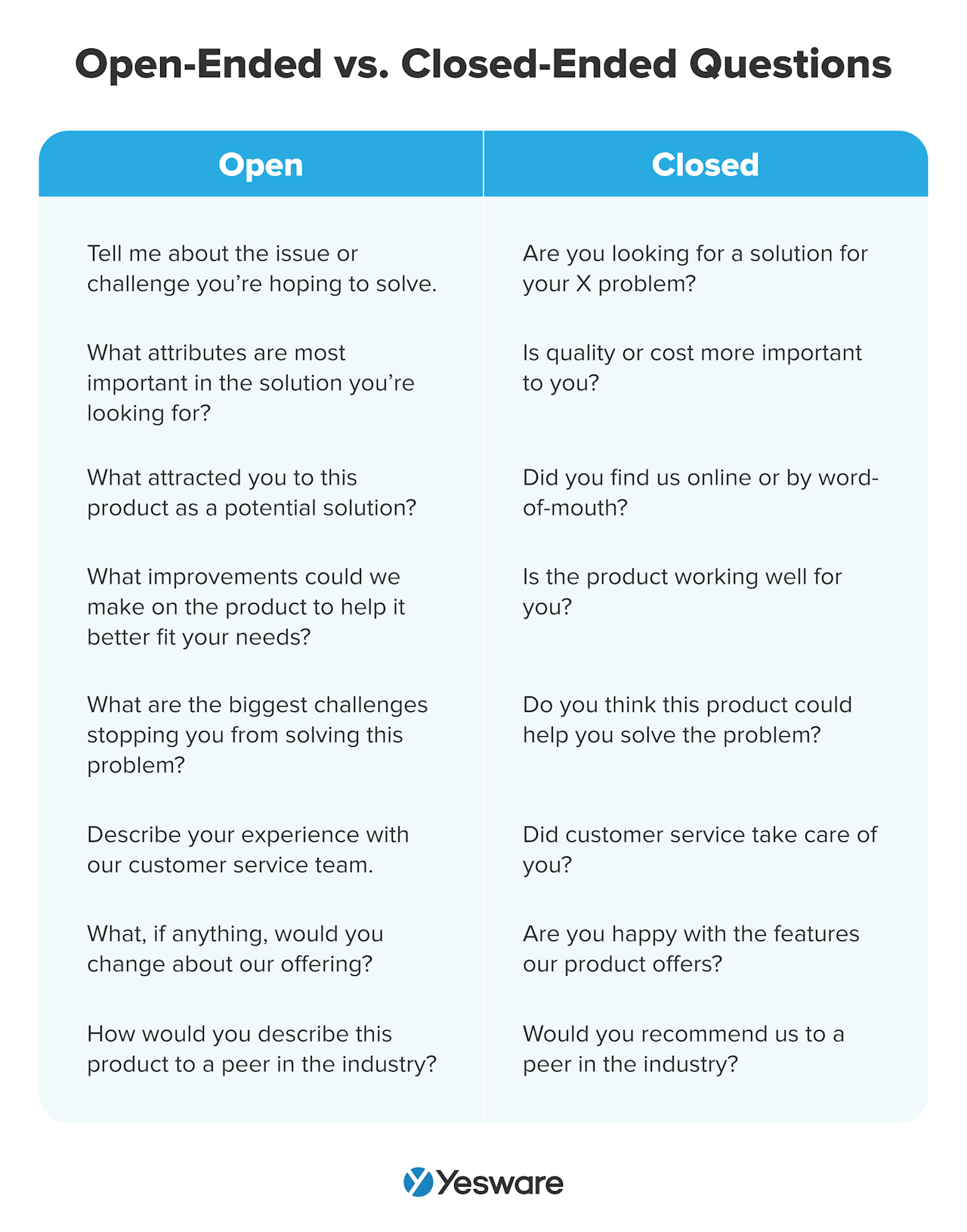 This can sometimes feel intrusive for some salespeople, and it can take some trial and error to find the right tone.
This can sometimes feel intrusive for some salespeople, and it can take some trial and error to find the right tone.
But as long as you remain respectful and professional, try not to worry about overstepping — it’s human nature to want to talk about yourself, and most clients will jump at the chance to talk about their business to someone who shows interest in listening.
Open-Ended Questions
Here are some open-ended questions to try on your next consultative sales call:
- Tell me about what you’re looking to accomplish.
- What challenges have you faced in the past when trying to accomplish this?
- Have you tried to solve this problem in the past? How did it go?
- What worries do you have about facing this challenge?
Follow-up questions are also super helpful, and can often get even the toughest nuts to crack open (where appropriate, of course — remember to be genuine and only ask questions when it makes sense to do so).
Here are some follow-up questions:
- I heard you say X. Can you tell me more about that?
- Why do you think that is?
- What is your thought process behind X?
- Is there anything we haven’t discussed yet that you’d like me to understand about your business needs?
Notice that these questions are open-ended, probing (but not overly personal), and — most importantly — entirely focused on the customer. Asking the right questions will build trust and an eagerness to move forward.
Step 3: Active Listening
Heads up — this part is deceptively tricky, and probably more nuanced than you think.
The first (and easy) part: try to listen at least twice as much as you talk. Pretty straightforward and easy to achieve with a little willpower and practice.
The next part, however, is often overlooked. Many salespeople claim to be great listeners, but the reality could not be farther from the truth.
“Listening” the way we’re talking about here isn’t just about hearing the client’s answers and coming up with a response on the fly.
The kind of listening we’re talking about is a bit more involved. It requires:
- Hearing what the client is saying
- Showing a genuine interest in understanding their concerns
- Quickly synthesizing what they’re saying with what you already know, and using both pieces to read between the lines
- Problem-solving directly within the sales conversation
This skill is called active listening, and it’s one of the most important aspects of effective consultative selling.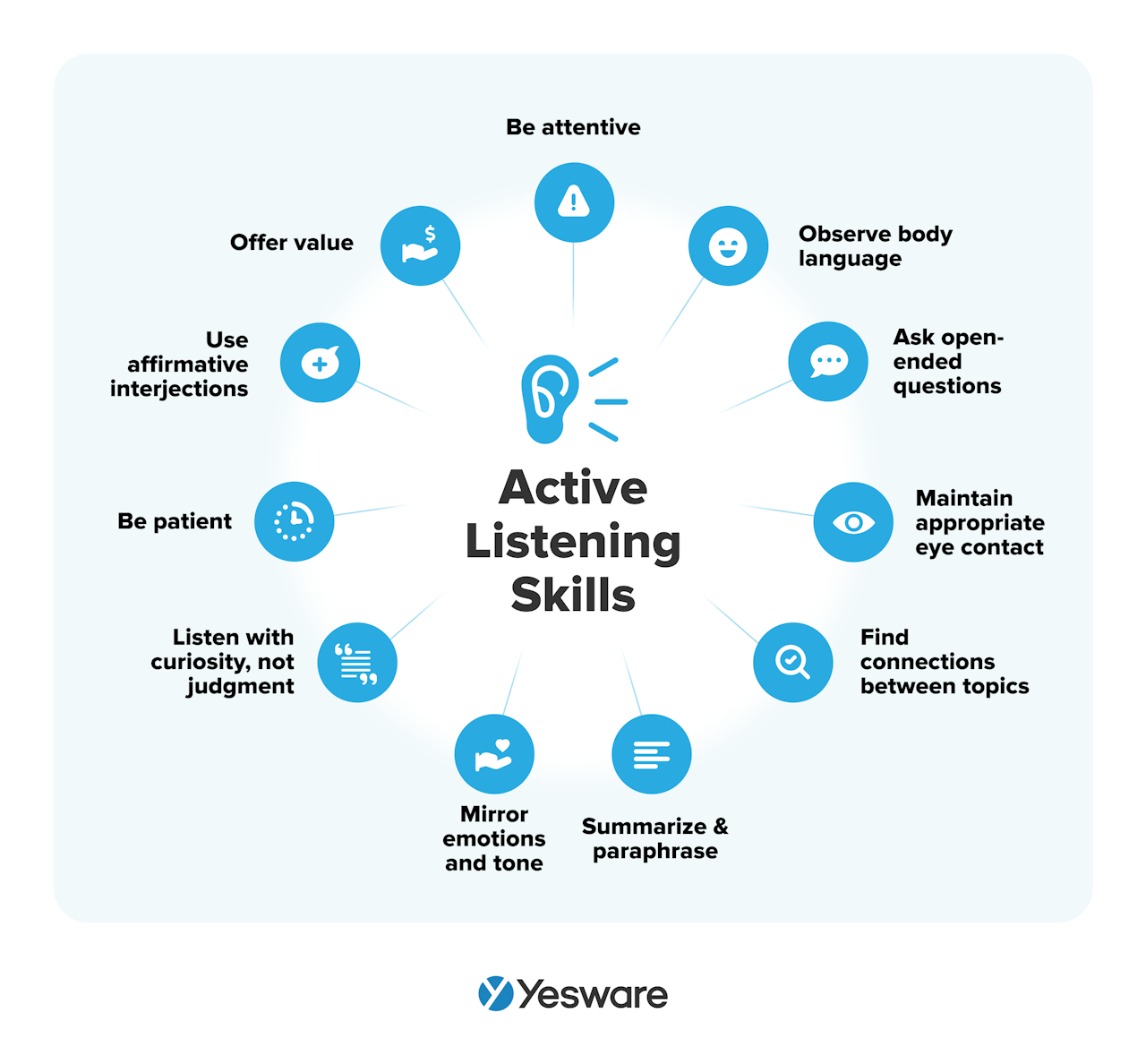 Being an active listener is actually pretty simple, and most people practice this skill (perhaps subconsciously) with the people they’re closest to.
Being an active listener is actually pretty simple, and most people practice this skill (perhaps subconsciously) with the people they’re closest to.
For better or for worse, somewhere along the line, the traditional sales model adopted a pushier and less personal approach — which is why active listening within a sales context can feel a bit unnatural. But a little practice goes a long way!
Step 4: Qualify Prospect
As you ask the prospect thoughtful questions, listen carefully to their answers. This is the sales rep’s opportunity to qualify the prospect and determine how well-matched they are to the solution.
In particular, the two areas that sales reps need to qualify carefully are decision-making power and budget.
As the conversation develops, be sure to confirm that the prospect with whom you’re speaking has decision-making power in their organization. If not, try to tactfully find a way to ask to be connected with someone who does.
It’s also important to understand the prospect’s budget needs. Keep in mind that money is one of the most common sales objections, so don’t be surprised if the initial budget conversation has a tone of resistance and concern. As a consultative sales rep, it’s up to you to thoroughly understand the prospect’s needs, their resources, and the ways in which you can package your solution to meet those specifications.
There are various lead qualification frameworks to help you effectively qualify prospects, such as BANT (Budget, Authority, Need, Timeline): 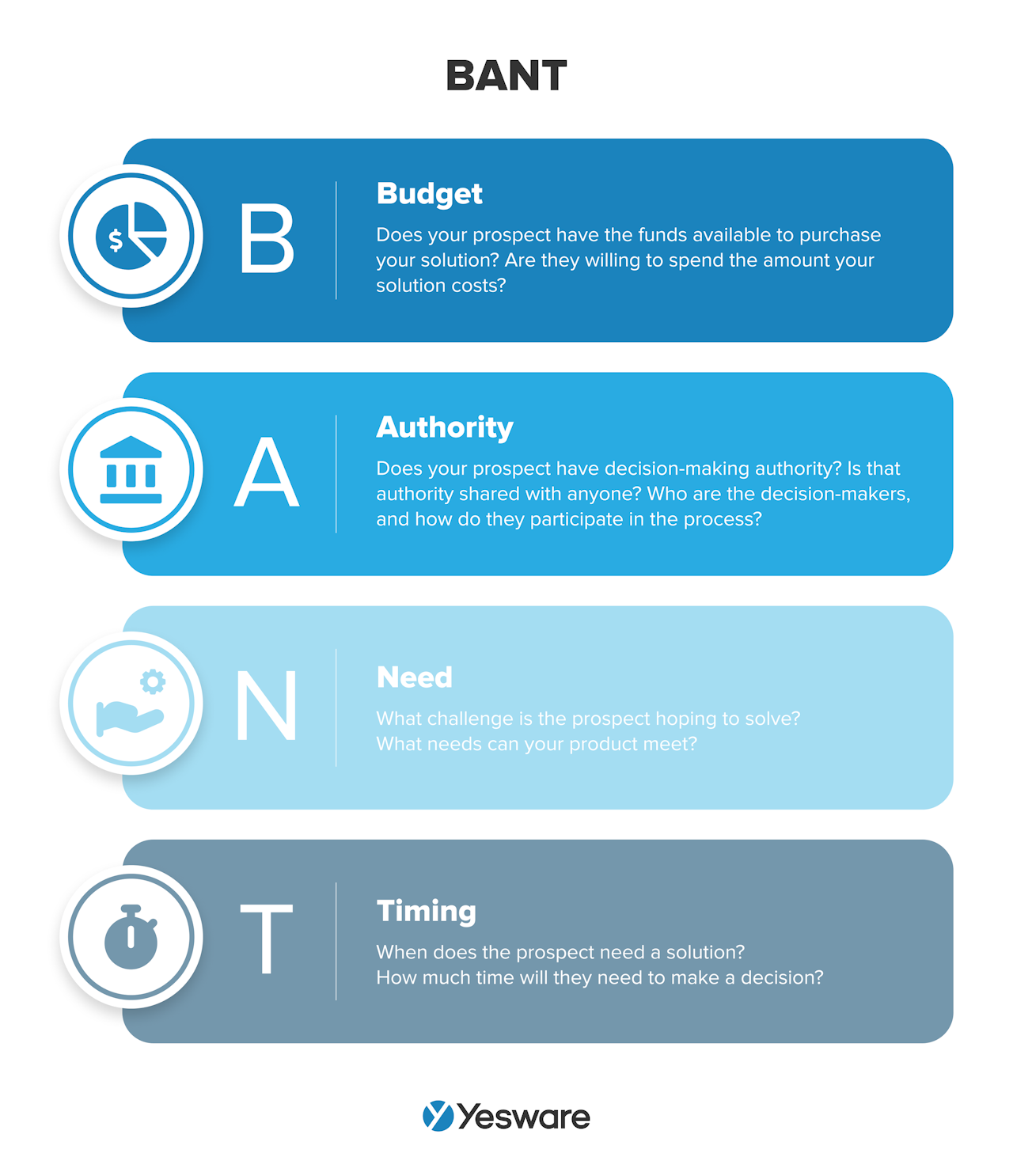 And MEDDICC (Metrics, Economic Buyer, Decision Criteria, Decision Process, Identify Pain, Champion, Competition):
And MEDDICC (Metrics, Economic Buyer, Decision Criteria, Decision Process, Identify Pain, Champion, Competition): 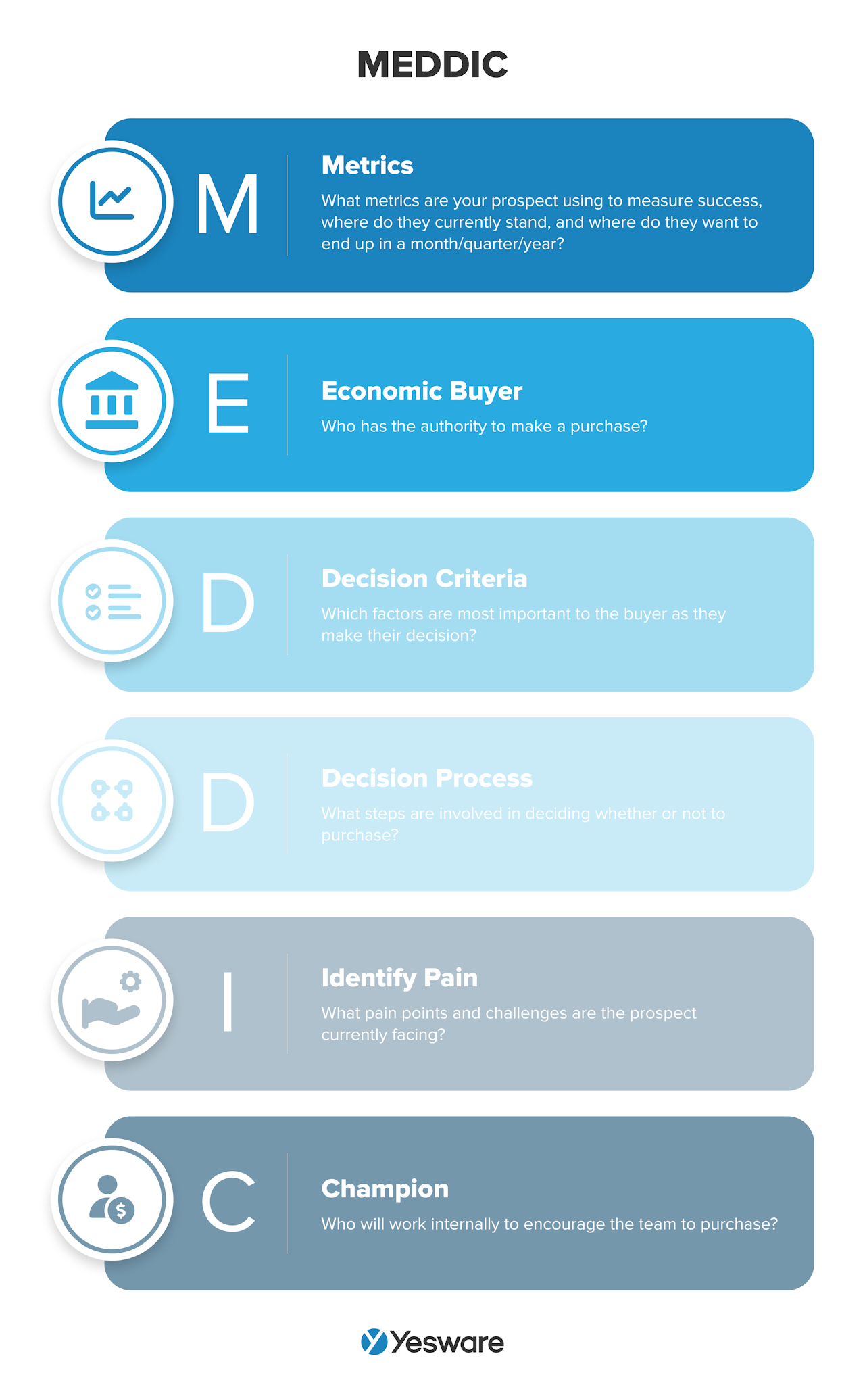 Qualifying the prospect might seem like an extra effort, but it ultimately saves time in the long run. Most sales reps know firsthand how frustrating it is to move a prospect down the pipeline and pour resources into the opportunity, only to find out after pitching that the prospect doesn’t have the authority or the money to move forward.
Qualifying the prospect might seem like an extra effort, but it ultimately saves time in the long run. Most sales reps know firsthand how frustrating it is to move a prospect down the pipeline and pour resources into the opportunity, only to find out after pitching that the prospect doesn’t have the authority or the money to move forward.
Trying to close unqualified prospects is a waste of time and effort. The small amount of extra planning and conversation that it takes to qualify can save hours, days, or even weeks’ worth of work.
Step 5: Inform/Collaborate
The consultative selling approach is all about solving customer pain points and problems. 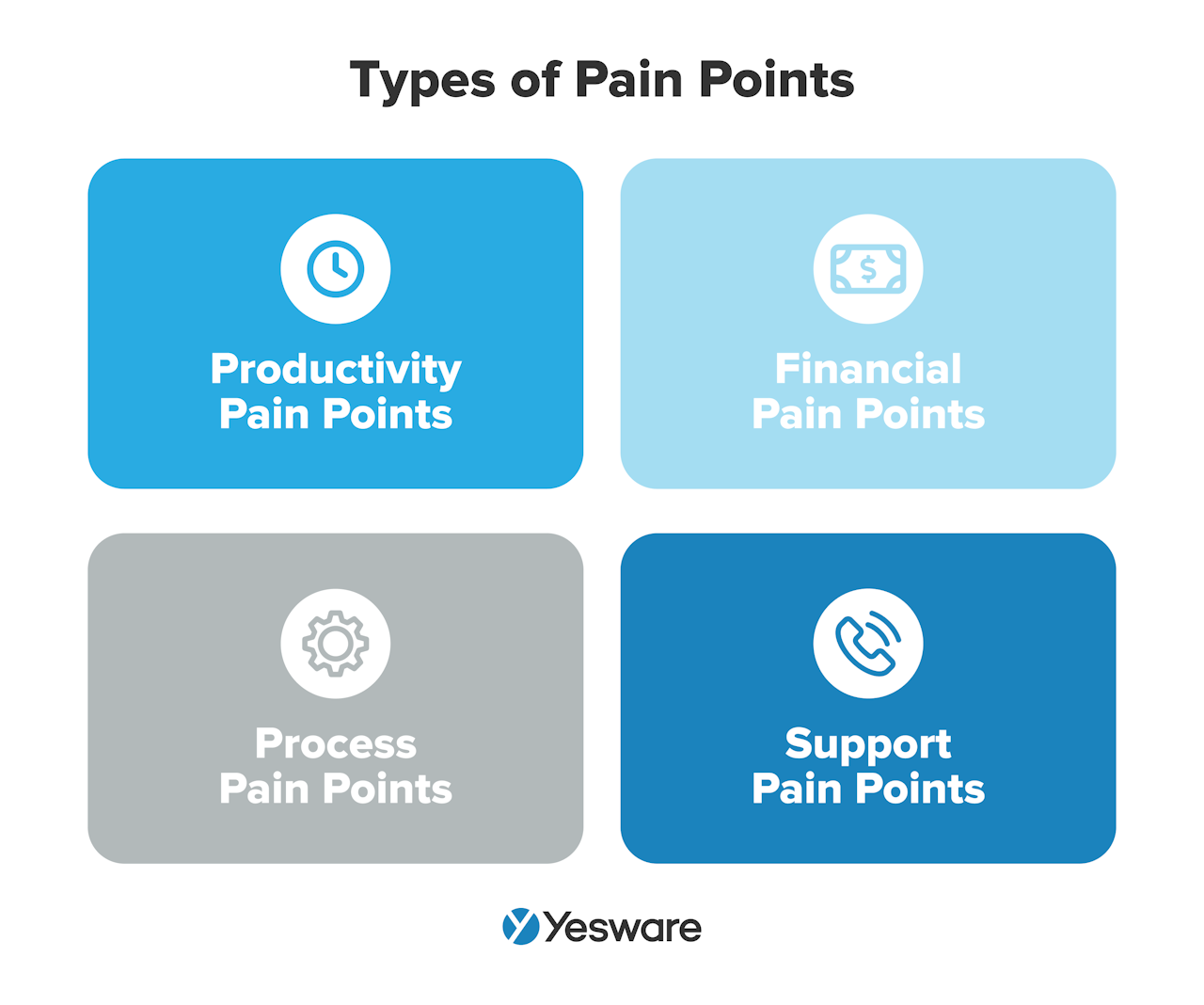 You are the expert on your product; use that expertise to your customer’s advantage. Share what you know, when appropriate — but make sure you share in such a way that won’t eliminate the need for the customer to eventually hire you.
You are the expert on your product; use that expertise to your customer’s advantage. Share what you know, when appropriate — but make sure you share in such a way that won’t eliminate the need for the customer to eventually hire you.
In some cases, this might mean offering knowledge. It could also mean coming up with a strategy on the fly, or even providing referrals that aren’t directly related to your product. In other words, don’t shy away from sharing something that’s helpful, related, and valuable — but try to do so without giving away the product or service for free.
When done properly, taking on the role of consultant or a trusted advisor before you’re technically hired as such will pay off. Think of it like giving a free sample at the grocery store; if you’re confident in your offer, let them have a taste. Chances are, they’ll want the whole package.
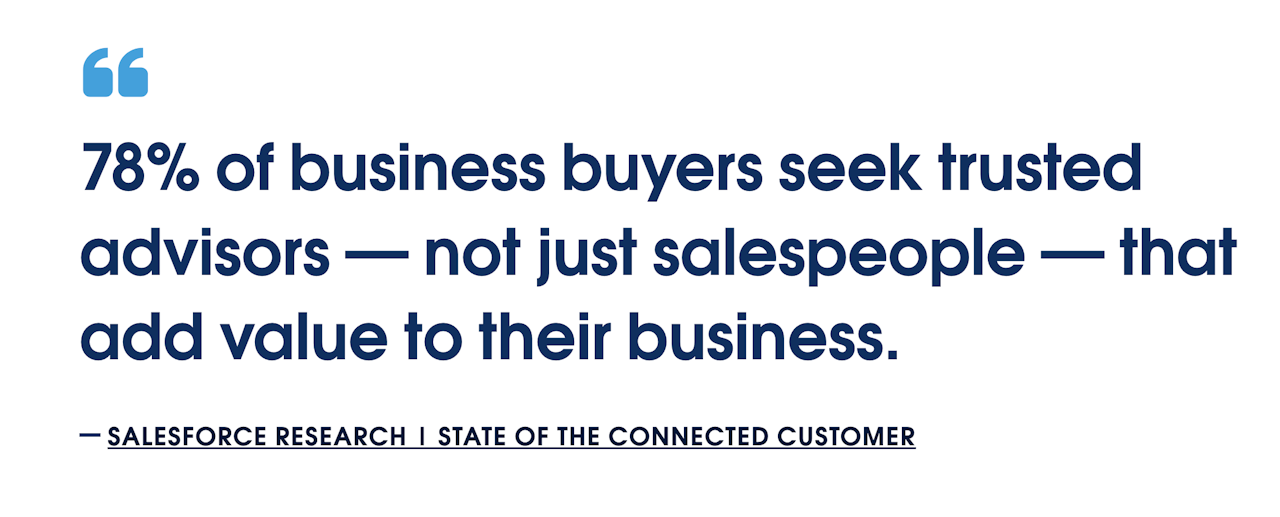
This step is also where you can begin speaking directly to your product or service, but take care to avoid the standard old list of features or benefits.
Instead, craft your talking points specifically around the concerns the client has already shared with you. If one of the features of your product is integration with Gmail, but your client uses Outlook, skip that part. The feature may be great — maybe even the top-selling point — but bringing it up will make the client feel like you haven’t listened at all.
Between your research, questioning, and active listening, you will have created a client puzzle, of sorts. But the puzzle is missing just a few pieces. Those missing pieces are their pain points. Your job is to take your product and shape it into the exact shape of those missing puzzle pieces for your client.
Step 6: Close
In an ideal world, all of your deals would close seamlessly after all of that listening, understanding, and solution-providing. In reality, though, that won’t always be the case. You may or may not close the sales at the end of the conversation.
And that’s okay.
Consultative selling isn’t about how many deals you close in a week, or how much each contract is worth. You need to be in it for the long game — remember, the point is not the product, but the relationship. Your success should be measured by how well you were able to meet your client’s needs.
The biggest mistake most salespeople make with this approach is trying to close too soon. The reality is, it takes a while to close:
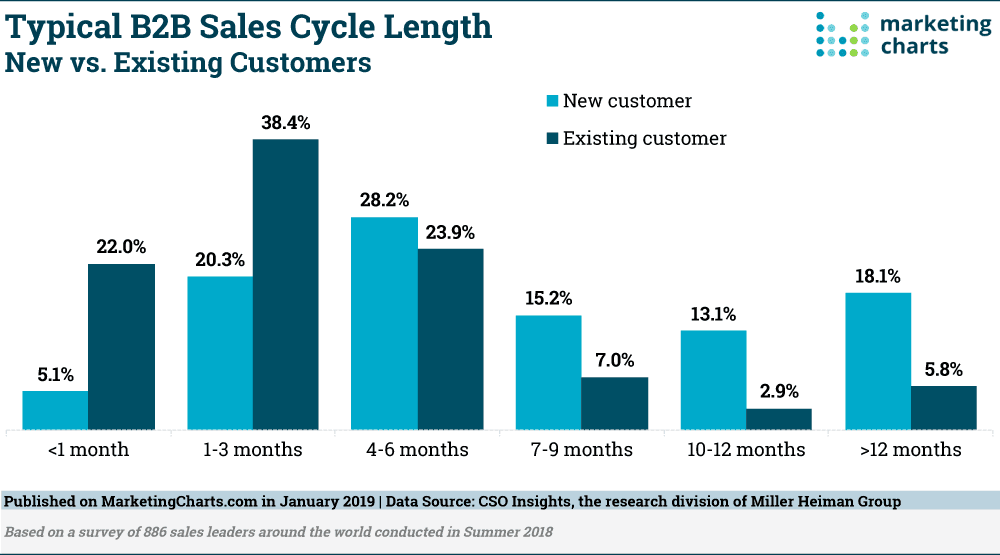
The close should feel natural and mutually beneficial — if it doesn’t, it’s not the right time to close. Either it’s not a good fit in general (that’s okay too!), or the prospect needs more time.
In that case, be patient. Feel free to follow up with a friendly and professional email, but leave the last-minute sales pitch out. Instead, briefly recap the conversation and let the client know that your door is always open for further discussion.
Many times, the decision-maker simply needs time to consider the offer and will end up moving forward. And even if you don’t end up closing the deal, you’ve now formed a solid professional relationship that could always become fruitful in the future.
Tip: Grab some data-backed findings below to enhance your consultative sales process.
 Sales Engagement Data Trends from 3+ Million Sales ActivitiesLooking at millions of tracked email activity over the past few years, this ebook is filled with our top studies and findings to help sales teams accelerate results.
Sales Engagement Data Trends from 3+ Million Sales ActivitiesLooking at millions of tracked email activity over the past few years, this ebook is filled with our top studies and findings to help sales teams accelerate results.
Consultative Selling Principles
The consultative selling approach relies heavily on a trusting relationship between buyer and seller. It requires the seller to maintain control over the course of the conversation without making the prospect feel coerced or influenced.
Here are some of the foundational components of consultative selling to keep in mind throughout the selling process. 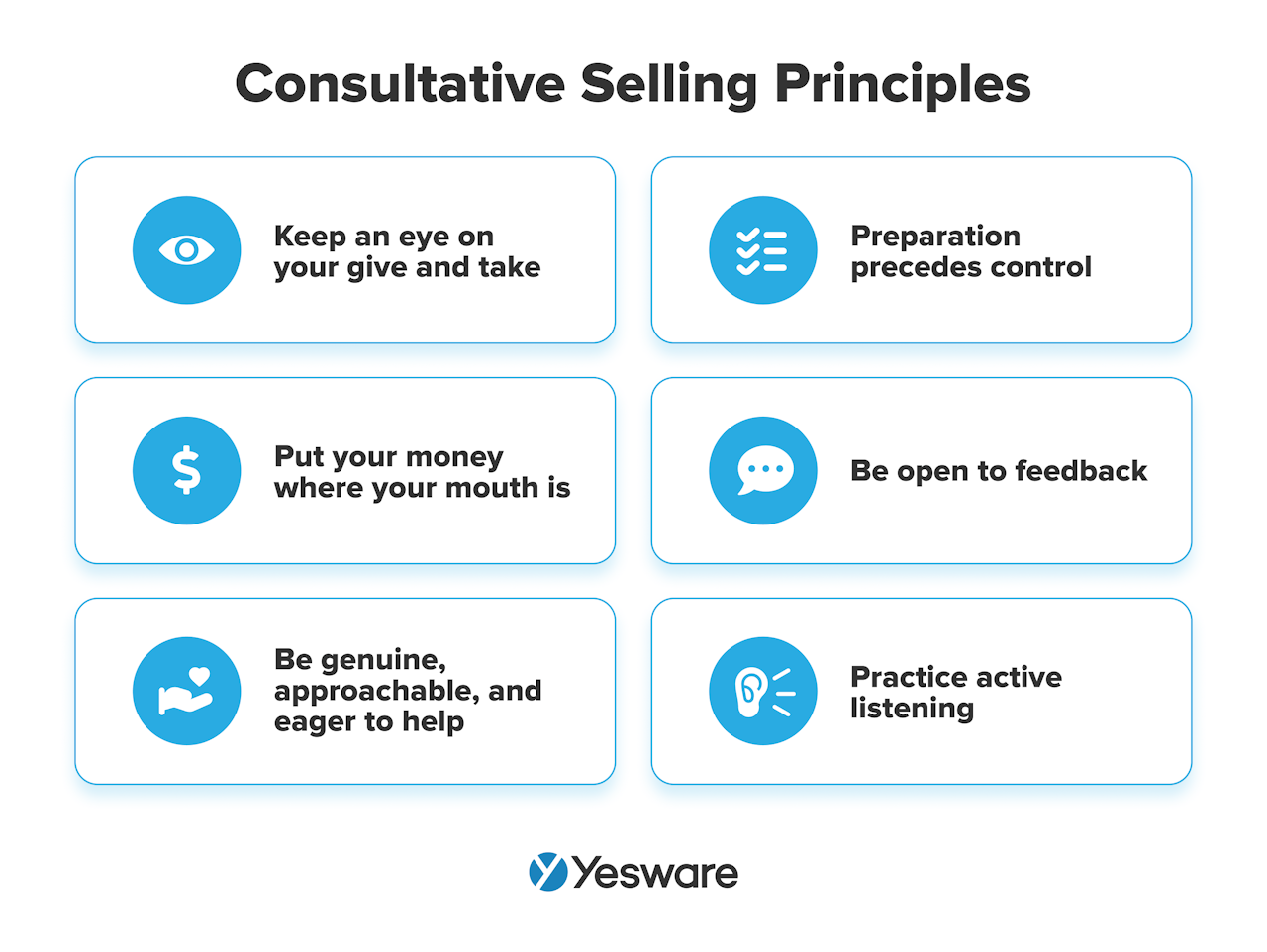
1. Keep an Eye on Your Give and Take
It’s natural for consultative sellers to feel eager to ask an exhaustive list of questions. After all, a consultative selling approach requires sales reps to have a deep understanding of the buyer’s problem and specific needs.
But reps should take caution against asking too many questions, or with too much intensity. The wrong tone here can quickly make a sales meeting feel like an interrogation, and that will get in the way of building trust.
Instead, make sure you take the time to offer insight throughout the conversation alongside your list of questions. Valuable, tangible insights offered with no strings attached go a long way in building your credibility and likeability, and earn you the right to ask deeper, more thought-provoking questions as your rapport grows.
2. Put Your Money Where Your Mouth Is
In a sales world that’s increasingly digital/remote, it can be hard for sales reps to build trust and credibility from behind a screen. One way to achieve this is by being mindful that your actions line up with your words and intentions.
Sellers can achieve this by doing things like following up when they say they will or referencing specific insights or anecdotes that the buyer previously shared during a conversation. These small but powerful gestures show sellers that you mean what you say, and that you’re invested in them as a person with real problems — not just what they can do for your quota.
3. Be Genuine, Approachable, and Eager to Help
It’s important to maintain professionalism, but make sure to balance that formality with an air of genuine friendliness and approachability.
Be enthusiastic about what you’re selling. Talk about your product with conviction — especially the way it helps people solve problems. Just make sure you maintain honesty and integrity, and be careful not to brag. Go for confidence and capability, not arrogance and bravado.
4. Preparation Precedes Control
One of the cornerstones of consultative selling is a sales rep’s ability to maintain control of the sales conversation. The best way to ensure this control is through careful preparation in advance of sales conversations.
Sales reps should come prepared to prove their product’s effectiveness with several anecdotes and real-life examples of relevant case studies and testimonials. When sales reps can assert confidence in their offer, and then hand over data to back it up, it demonstrates credibility.
Just remember to make sure you don’t cross the line into pushiness or dominance.
5. Be Open to Feedback
From a consultative seller’s perspective, there’s no such thing as bad feedback. Every sales objection is an opportunity to learn more and further personalize a solution to the buyer’s needs.
Frequently take time to check in with the prospect to learn more about their perspective, and take notes on what they share. This feedback can help you make connections and draw insights that the buyer themself may not even be aware of.
6. Practice Active Listening
Consultative selling is a customer-centric process. The most important part of the approach is that sellers develop a deep, thorough understanding of what a prospect needs and values in a solution.
Sellers can use active listening skills to help them get the information they need to tailor a solution for each buyer. Active listening helps buyers trust that they and their needs matter to the seller.
Examples of Consultative Selling
The process is simple but can take some practice. Here are a few examples of consultative selling in action. Notice that there are a variety of outcomes — this approach doesn’t always take a Point A to Point B route, but it does always end up with a very happy customer.
1. A Simple Tip Goes a Long Way
An energy-based SaaS company is working with a large city to cut their municipal buildings’ energy costs. The client approaches the seller with the belief that they would need to re-outfit their buildings with an entirely new electrical system.
Through effective questioning, the sales rep learns that the city is losing a large chunk of money by over-utilizing their hot water heater during peak usage times — a problem that could easily be solved by simply shifting their bulk usage time by an hour. The sales rep offers this advice (for free, and independent of the service the client requested) and then goes on to speak on additional tactics and savings that could be achieved through a handful of their programs. He also speaks to the pros and cons of re-outfitting the electrical system as originally requested by the client.
As he presents the various programs, he speaks directly to the concerns shared by the client earlier in the conversation. This helps the client feel heard, helped, and in control, leading him to eventually opt into two of the services suggested by the rep before re-outfitting the buildings.
2. Overdeliver by Underselling
A small business blog was struggling to make sense of their engagement data. The blogger reached out to a conversion optimization agency for help, her main concern being her excessively high bounce rate. She approached the agency with the intention of utilizing their copywriting and web design services to hopefully entice people to stay longer on her page.
Although the blogger had already accurately pinpointed her issue — the bounce rate — the salesperson asked some follow-up questions.
Follow-up Questions:
- What were her thoughts on the copy, as it was currently? Did she like it, or did she think it could be better?
- Was she happy with her current web design?
- Did she know what people were doing once they got to her blog — were they scrolling at all? Getting stuck somewhere?
These were questions that the sales rep could have easily forgone. Instead, he dug a little deeper to get a full picture. The conversation was an easy back-and-forth and somewhat off-the-cuff, going with the flow until all bases were covered.
In learning that the blogger really didn’t want to hire another web designer or copywriter — she was quite happy with the current design, and believed that her writing should be authentically her own — the sales rep suggested leaving the web design and copy as-was, at least in the short term.
Instead, he suggested that the blogger use their heat map analysis service for a month to further diagnose the bounce rate problem. The blogger agreed, and in turn, learned that about 60% of her visitors were experiencing pop-up problems immediately upon arriving at her page. Problem solved!
While this may not seem like an outright win for the sales rep, it actually couldn’t have gone better from a consultative sales perspective. The rep didn’t “close the deal” — he didn’t sell the more expensive copywriting or web design services — but he did build rapport, and a really solid foundation for a trusted client/provider relationship.
The blogger now knows that this agency truly has her success in mind, and also cared enough to ask about and honor her personal preferences for her business. It’s highly likely this customer will consult with the agency for all of her future marketing needs.
3. Expertise Is Priceless
An Amazon FBA seller reached out to a manufacturer for a quote for a new product he was hoping to launch. Before providing the requested quote, the manufacturer asked the Amazon seller where he planned to sell the product, and what the product market currently looked like. In hearing the market conditions, the supplier was able to recommend an easily sourced bonus product that could be added at very little extra cost.
The supplier was also able to provide a couple of case studies of other sellers who had done the same, which increased their sales significantly.
Imagine the impression this “sales call” made on the Amazon seller. It would have been much easier for the supplier to crunch the numbers, put the quote in front of the client, and hope for the best.
Instead, with just a couple of simple, open-ended questions, he showed the client:
- He’s highly knowledgeable about the market
- He’s genuinely interested in seeing the seller succeed
- He has great business sense, and could potentially be a valuable asset to the seller’s business
It would be hard to imagine a scenario in which this client didn’t move forward with this particular manufacturer.
Consultative Selling Strategies for Success
Keep these tips in mind to hone in on your consultative selling strategies!
1. Be Curious
Remember to aim for open-ended questions. This is an instance in which immediate digital access to information presents a challenge — what kinds of questions can you reasonably ask someone when you can find the answer to just about any of them online?
The key here is curiosity. Behave like an investigator, not an interviewer. Instead of asking questions to checkboxes, consider asking questions that don’t have right or wrong answers. Your job is to synthesize the information, read between the lines, pinpoint the problem — and then craft your offer as the solution to their highly unique circumstances.
2. Be Authentic
As we mentioned, it goes a long way in the eyes of your client to be an expert. You want them to see you as an authority on not only your product but also the field in general. And offering value, as we discussed above, is a great way to do that.
But offering your expertise can be a slippery slope. If you go too heavy on “expert,” you run the risk of seeming too authoritative, too braggy, or — worst of all — a phony.
The antidote to these pitfalls? Be authentic. Both in acknowledging the pain points and in wanting to solve them.
Be authentic in your offer to share some knowledge at no cost. Be authentic in the conviction that you are your clients’ trusted consultant, and that you have their best interest in mind — even those of your clients who still fall in the “potential” category.
3. Follow-Up
Remember, the consultative sales approach requires more time and patience than the more traditional methodology. It’s easy to get invested in every relationship — that’s the nature of the process.
Sending a follow-up email to your potential customers will maximize the effort you put into each relationship. 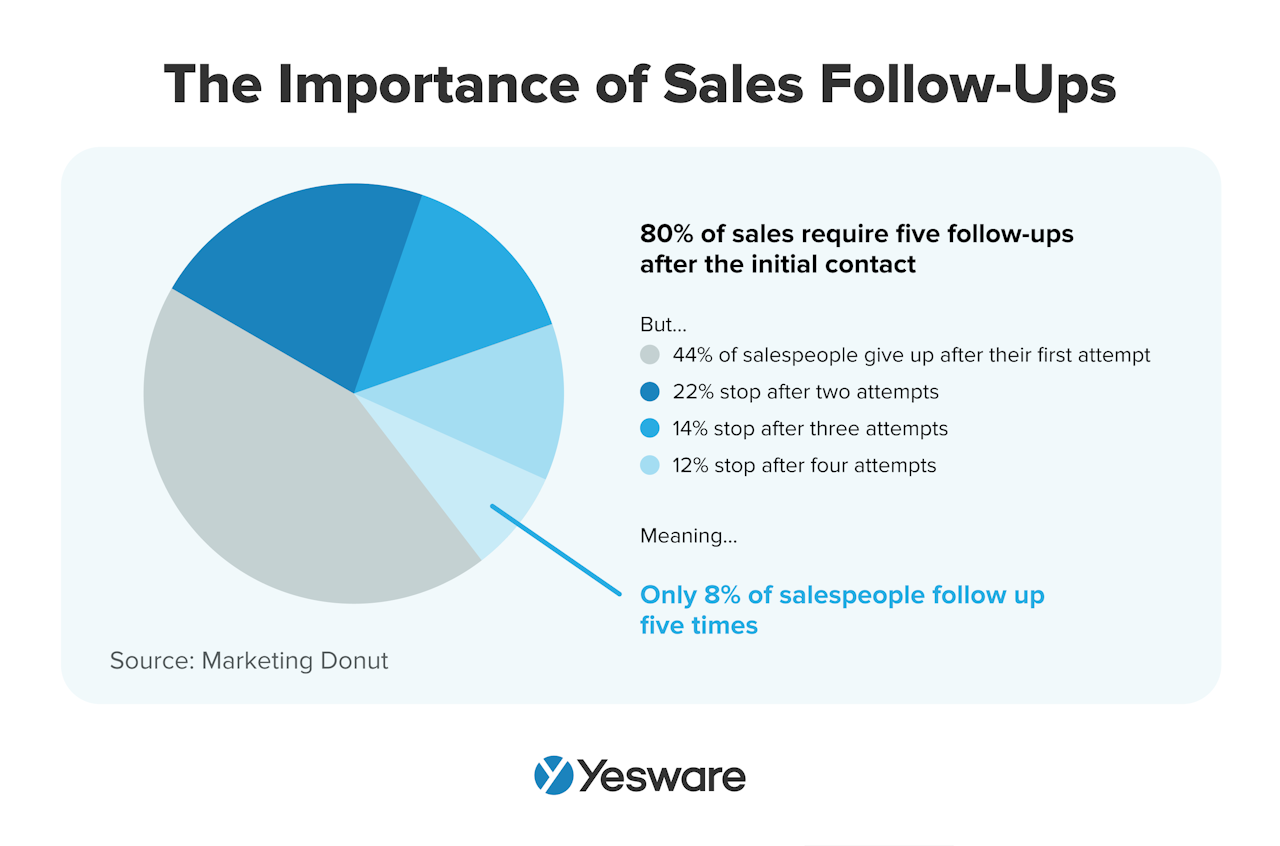 Tip: Yesware makes it incredibly easy to follow up with all of your clients in a personalized, prompt, and streamlined way. With Yesware Campaigns, you can automate your follow-ups to go out when prospects don’t respond to the previous message. The tool will automatically remove recipients who reply or book a meeting.
Tip: Yesware makes it incredibly easy to follow up with all of your clients in a personalized, prompt, and streamlined way. With Yesware Campaigns, you can automate your follow-ups to go out when prospects don’t respond to the previous message. The tool will automatically remove recipients who reply or book a meeting.
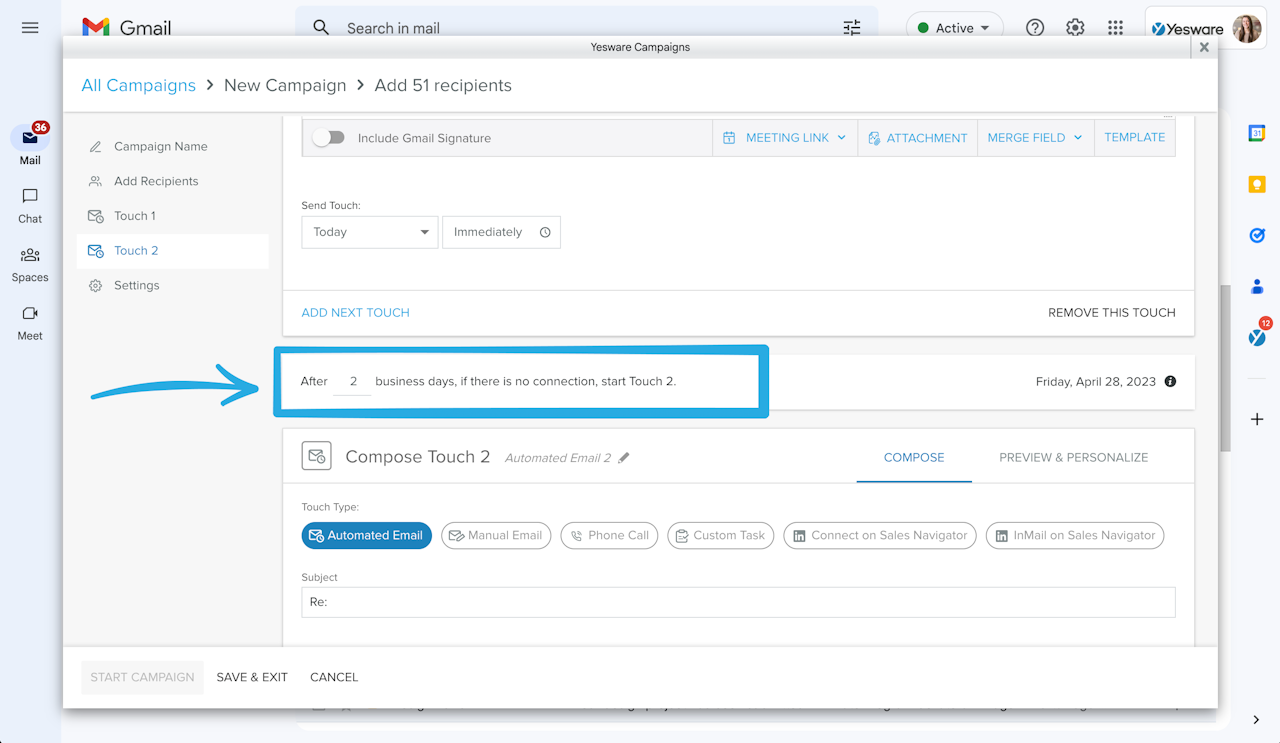
4. Lead With a Willingness to Help
Those hoping to adopt a consultative mindset should work to maintain a mindset of assisting buyers and solving problems.
A consultative strategy only works if sellers can delay the satisfaction of closing the deal in favor of ensuring the buyer feels completely heard.
The more a sales rep can show they’re committed to meeting buyers’ needs, the more open those buyers will be.
5. Go In With a Plan
Remember — consultative selling requires intentional and methodical research in advance of every sales conversation. Use that research to help you create a loose framework for your meetings, and let the buyer know what you plan to discuss.
Of course, remember that this is ultimately all about the customer — if they need to go off script, give them the space they need to help them feel heard. But keep in mind that your job is to position yourself as an expert. Lead and guide the conversation in a way that helps the buyer and seller understand one another on a deeper level.
6. Understand Buyer Psychology
Consultative selling requires a deep understanding of human psychology, especially when it comes to the buying process.
Sales reps who practice this sales methodology know that all humans have a need for autonomy, competence, and relatedness — and this is especially true when it comes to decision-making and purchasing power. They can use this knowledge to design their sales process around those core needs.
Also, understanding the principles of sales psychology will help explain why customers think, behave, and feel the way they do throughout the buying process. 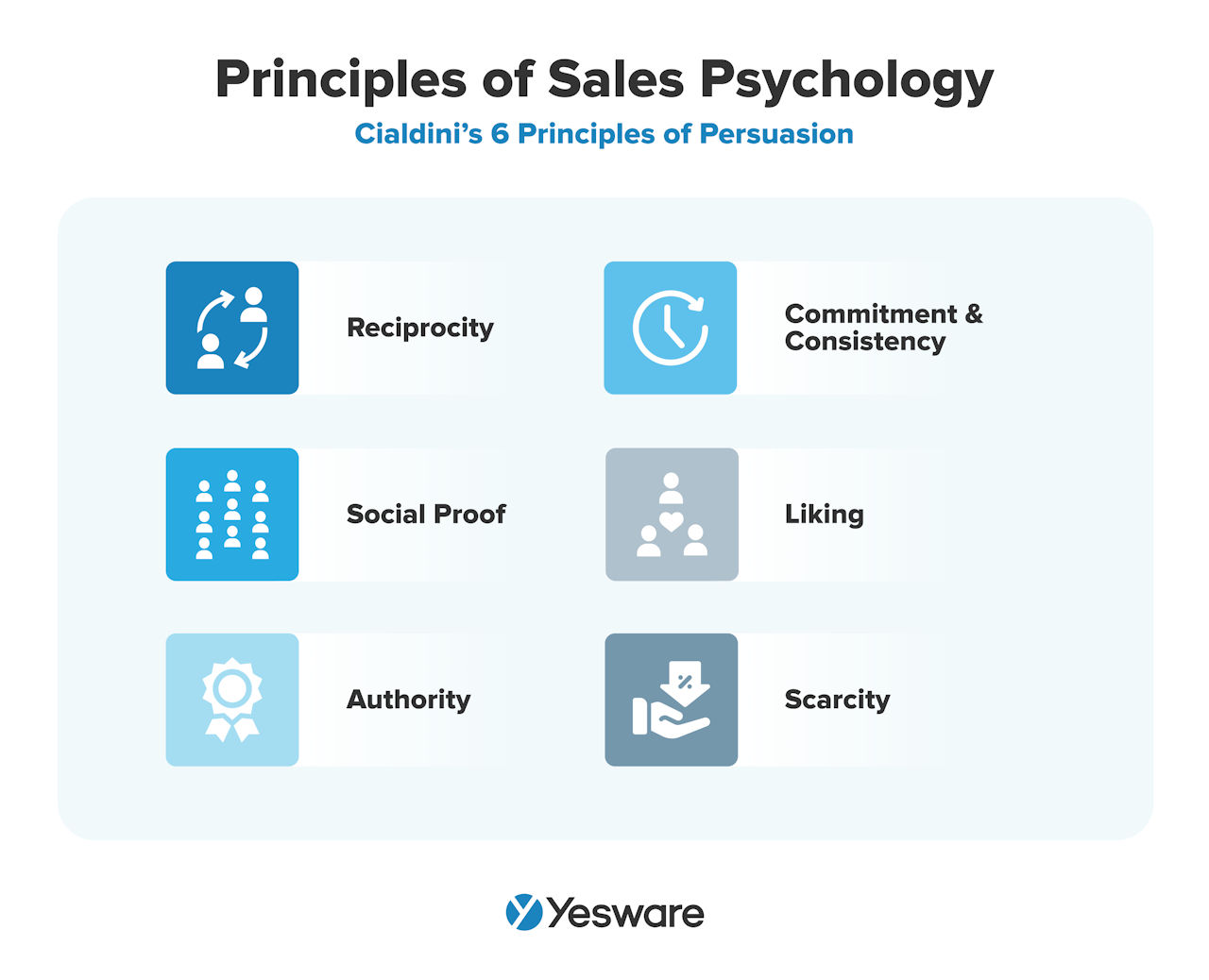 Sales reps should stay up to date on psychological research that will help them guide conversations productively.
Sales reps should stay up to date on psychological research that will help them guide conversations productively.
7. Keep an Open Mind
Make sure you keep an open mind while you’re listening to prospects, and allow them to speak about their concerns candidly and with trust that you can handle their frustration.
Don’t push back against anything you hear, even if you believe the buyer is misinformed about what they need; practice active listening and remember that the buyer’s truth is the most valuable piece of information you need when crafting your value proposition.
8. Utilize Facts
One thing that consultative sellers need to be mindful of is the human tendency to operate based on underlying assumptions rather than facts. This is one example of anchoring, the psychological principle in which people rely too heavily on one piece of information, causing them to miss other valuable information as they focus on the singular “anchor” detail.
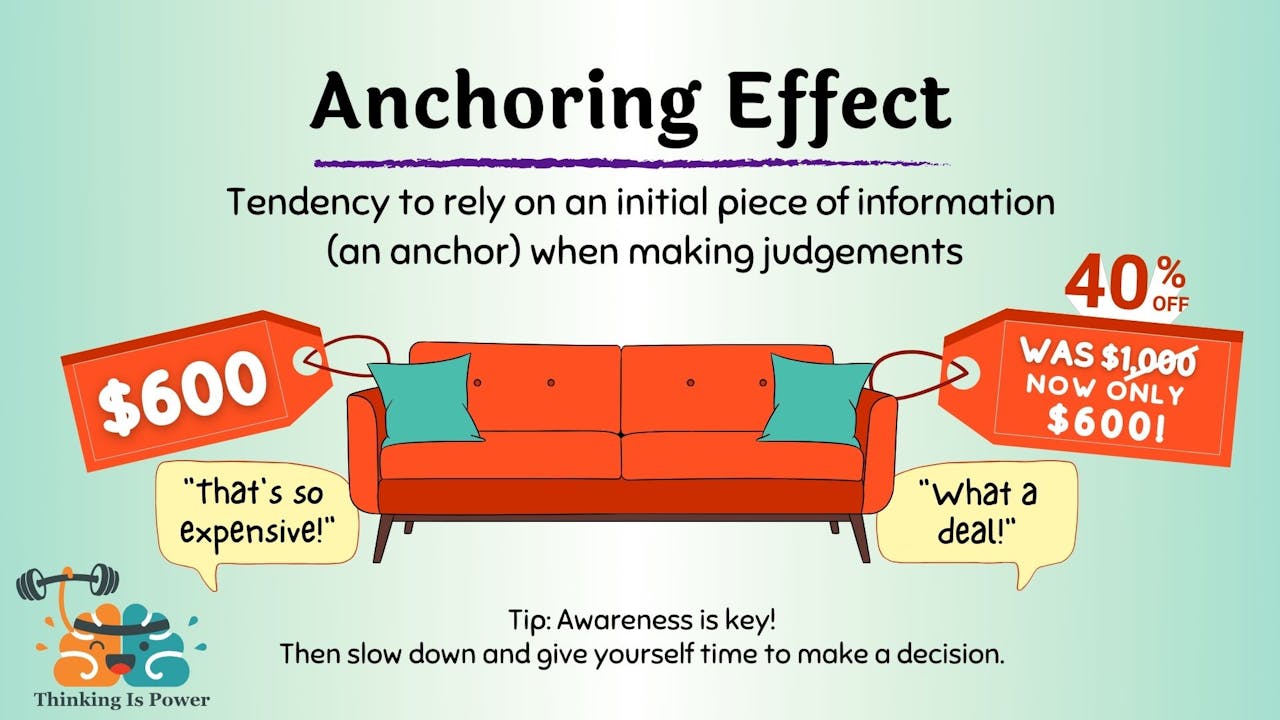
For sales reps, anchoring sometimes looks like attaching too strongly to their own assumptions about a prospect or their offer.
Remember, active listening is one of the most important skills for a sales rep to master. It can help prevent anchoring and encourage the conversation to focus on facts shared directly from the prospect. Many sales reps also find that providing educational materials throughout the sales process can help structure conversations around facts instead of opinions and assumptions.
One thing to note: as you listen to gather facts, you may notice that the prospect seems to contradict themselves or offer conflicting information. This can be a normal part of the consultative selling process, as both parties dig very deep to determine the best-fit solution. But it’s up to the seller to be a keen listener, identify those discrepancies, and (respectfully) get to the bottom of them. If you approach this task with the right mindset, it can make a great impression on the prospect regarding your listening and critical thinking skills.
Consultative Sales Skills to Master
Consultative selling takes time and practice to master. As you practice this sales approach in the field, be mindful of the following skills. Each of them will improve all aspects of the consultative sales process.
Be an Expert in Your Industry
Successful consultative sellers know how to present themselves as experts in their industry.
The first step in achieving this is to become an actual expert — buyers will be able to spot phony expertise a mile away. Spend time reading articles, newsletters, and press releases about happenings in your industry. Listen to podcasts and webinars. Attend seminars and networking events. LinkedIn is also a goldmine of industry knowledge and recent events. Be hungry for knowledge about your field; this will translate into the sales process.
(To go the extra step, do the same kind of research for the prospect’s industry, too.)
It’s also important, though, that you use your expertise wisely. There’s a fine line between someone who’s very knowledgeable and someone who’s a know-it-all. Take care with the way you share your insights.
One way to navigate this balance is to treat the prospect like your equal in terms of expertise. Assume that they’ve done their research just as much as you have; your job is to teach them how to use their knowledge to make educated purchasing decisions.
Social proof, like case studies and testimonials, can also go a long way in helping you seem credible and trustworthy.
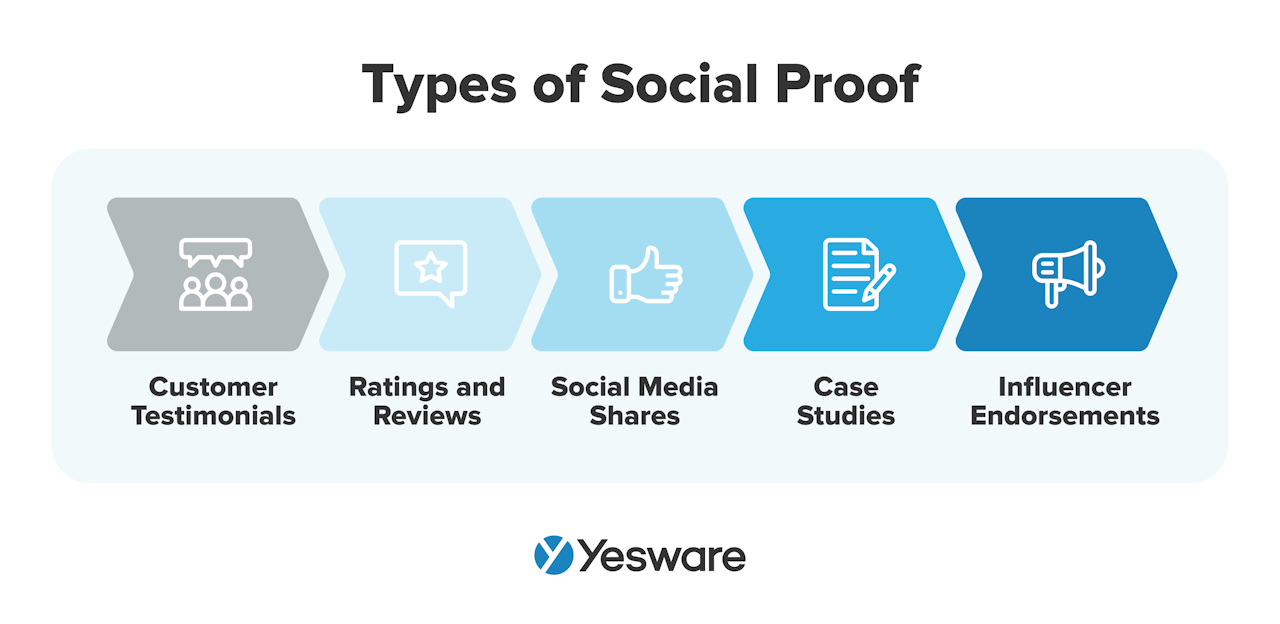
Master Your CRM
Consultative selling requires sales reps to track and manage a ton of prospect data, which needs to be immediately available to them throughout sales conversations.
With that in mind, for consultative sellers to be as successful as possible, they need to learn how to leverage every last feature of their CRM system. 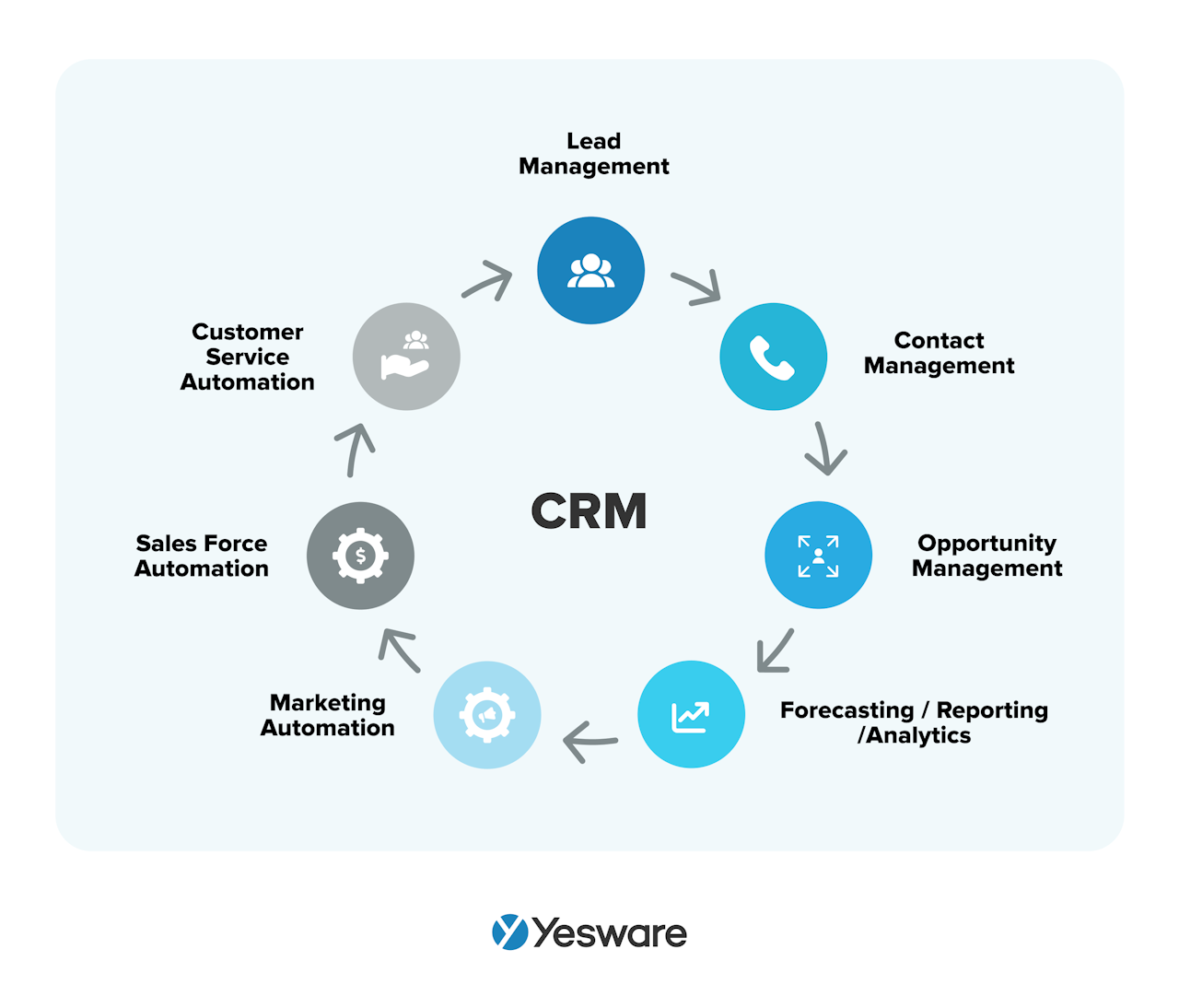 Ideally, your CRM platform should be focused on communication as well as data management. Sales reps should be able to communicate in the same place where data is stored and managed; this will help them save time and generate the best insights.
Ideally, your CRM platform should be focused on communication as well as data management. Sales reps should be able to communicate in the same place where data is stored and managed; this will help them save time and generate the best insights.
It’s also important that everyone on your consultative selling team is on the same page about the CRM expectations.
Learn How to Control and Guide the Conversation
This is another area of nuance for consultative sellers: controlling the conversation.
While it’s true that consultative sales reps should listen more than they talk, they also need to have a clear idea in mind of where the conversation needs to flow to get the information they need. This requires intentional pre-call preparation, as well as an ability to think on-the-go for effective follow-up questions.
It’s a good idea to be clear about your intentions for the conversation before you begin. This will help get you and the prospect on the same page and allow room for polite redirection if things get off track.
As mentioned above, an understanding of how human psychology works can also help you guide the conversation. Humans, for example, feel most motivated when they feel autonomy, competence, and relatedness to others.
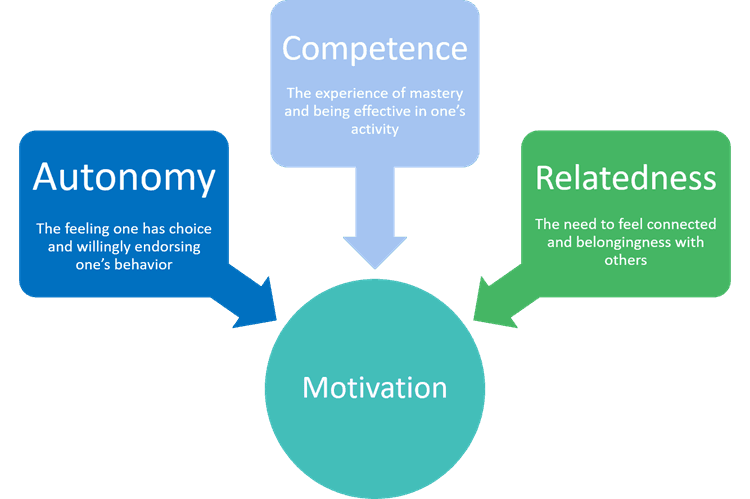
If you can guide the conversation in a way in which the prospect feels all three of those self-perceptions, they will be more likely to be motivated to purchase.
Remember — while a conversation outline is helpful, sales scripts should not be used in consultative selling (at least, not word-for-word). The conversation should feel natural and unforced, no matter how well you’ve prepared.
Build Your Personal Brand
Part of being a great consultative seller is having a “way” about yourself. It’s something that’s hard to define, but easy to spot. After all, a lot of consultative success derives from how prospects perceive the sales rep.
Some people refer to this as a seller’s “personal brand.”
To create this, it’s important to really dive into your industry and get to know your target markets. Think critically about the current state of your field, and form your own opinions. Share your thoughts on LinkedIn. Be outgoing at networking events. The more you can “come into your own,” the more successful you will be as a consultative seller.
Still, though, keep in mind — there is a fine line between being confident in your opinions and knowledge, and being too self-important. The first part of any consultative seller’s personal brand should be to help first.
Know Everything About Your Product/Solution
In addition to being an expert in their industry, consultative sellers also need to be top-to-bottom experts on their solutions. The more you understand the ins and outs of your product or service, the more easily you can make a personalized connection to each prospect’s pain points.
According to LinkedIn, the top three reasons for deals dying all relate to how well a sales rep understands their product in relation to a prospect’s unique needs.
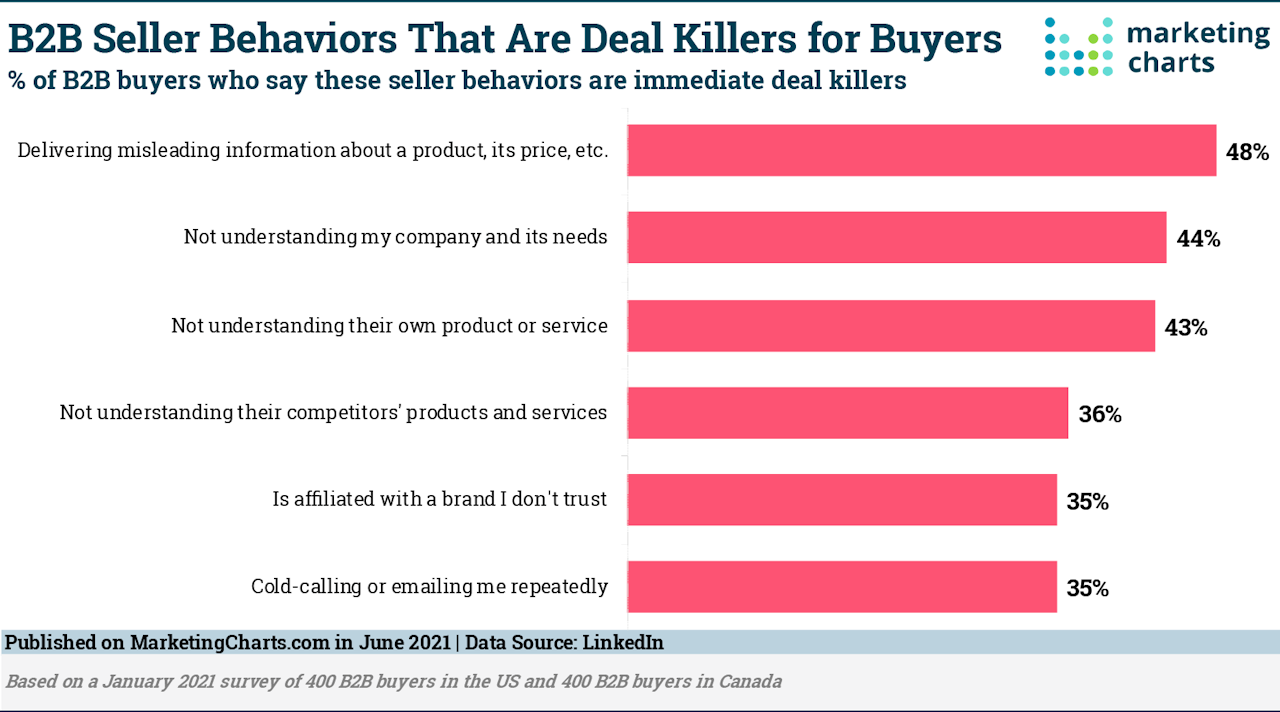
A successful consultative seller can convert their extensive product knowledge into a personalized solution for the prospect at hand.
This guide was updated on December 5, 2023.
Get sales tips and strategies delivered straight to your inbox.
Yesware will help you generate more sales right from your inbox. Try our Outlook add-on or Gmail Chrome extension for free, forever!
Related Articles
Casey O'Connor
Casey O'Connor
Anya Vitko
Sales, deal management, and communication tips for your inbox

